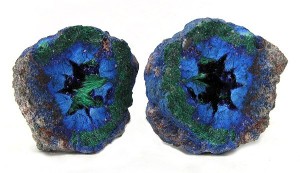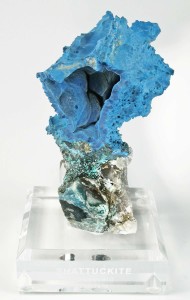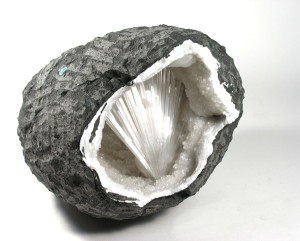Shining a Light on Geodes with The Arkenstone
Geodes appear in quite a few rock and mineral collections. They’re beautiful and fascinating, which is why we’ve decided to shed some light on them for collectors new to rocks and minerals.

What is a geode?
As shown above, a geode is a hollow, spherical rock, comprised of a crust of harder rock or mineral which encases a growth of crystals, or banded stone. These growth structures can vary greatly in size, color, internal shape, density, and chemical composition – though quartz is the most commonly discovered. Geodes themselves vary greatly in size, from those which could easily fit in the palm of your hand, to those which could easily encase a person.
How do geodes form?
Geodes can be created in a number of ways – but all involve the formation of a round cavity or bubble of sedimentary or igneous rock. In the case of sedimentary rock such as limestone or sandstone, the deterioration of organic materials (such as tree roots, bones, or even nodules of other minerals) leaves a bubble or gap in the sediment, which is completely surrounded by rock. In the case of igneous rock, expanding gas or steam is captured by cooling lava, creating hollow bubble or pockets within the rock bed.
After these hollow spaces or cavities have been formed, they are then subjected to eons of permeation by mineral-rich groundwater. Though the geodes themselves appear solid, they are actually comprised of porous rock, which allows moisture to seep through the surface into the cavity, leaving behind mineral deposits which build up over time, and form the bands of rock or crystals found within.
What are geodes made of?
The environment and location in which a geode is formed has a great impact on its chemical composition and mineral make-up. It may be helpful to think of a geode as a mini cave – the material of the encompassing rock, the mineral content and the acidity of the groundwater, and environmental factors such as temperature and humidity all interact naturally over time to create unique formations.
As time passes, the flow of water through the geode cavity (or the liquid trapped in the cavity) results in the deposit of minerals which form a crystalline structure of unique chemical composition. Eventually, those crystals grow to fill the geode’s cavity – resulting in the beautiful specimens you see today.
Though each geode is a unique individual, those found in the same locale will often contain crystals of similar composition. Dolomite, calcite, silica, and limestone are more commonly found in sedimentary rock, while clear quartz, smoky quartz, amethyst, and celestite may be more commonly found in igneous formations.
Where are geodes found?
Geodes can be found all over the world, but they tend to be found in higher concentration in the desert, or areas rich in volcanic ash or limestone. For those rockhounds seeking to add a few geodes to their mineral collections, there are many promising locations within the U.S., especially in the Southwest.
Nevada, Utah, Arizona and California all boast great collection sites (or geode fields) – although the area surrounding Keokuk, Iowa has also proven exceptionally rich to those seeking to improve their rock and mineral collections with a gorgeous geode.
For a more in-depth list of geode sites, check out this link. Or, click here to view more images, and take a look at some of the stunning specimens currently available to add to your rock and mineral collection at iRocks!

